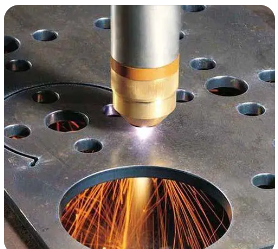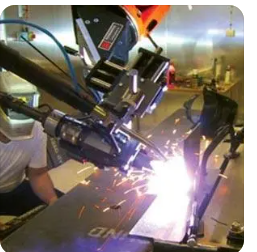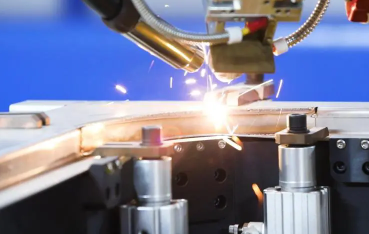The advantages and disadvantages of laser welding. In recent years, through continuous exploration and innovation by researchers, laser welding has been widely used in this society. The reason why it can be widely used is definitely due to its advantages, but there are advantages and disadvantages. Let's take a look at the advantages and disadvantages of laser welding.
Advantages and disadvantages of laser welding 1
advantage
1. The focused laser beam has a high power density and fast heating speed, which can achieve deep penetration welding and high-speed welding. Due to the small heating range of laser, under the same power and welding thickness conditions, the welding speed is fast, the heat affected zone is small, and the welding stress and deformation are small.
2. Laser can emit and transmit, and can propagate over a considerable distance in space with minimal attenuation. It can be used for welding at long distances or in difficult to reach aeas; Laser can be bent, transmitted, deflected, and focused through optical methods such as optical fibers and prisms, making it particularly suitable for micro parts, difficult to access parts, or long-distance welding.
3. A laser can be used by multiple workbenches for different tasks, including welding, cutting, alloying, and heat treatment, making it versatile.
4. Laser has little loss in the atmosphere and can pass through transparent objects such as glass, making it suitable for welding highly toxic materials such as alloys in sealed containers made of glass; Laser is not affected by electromagnetic fields, does not have X-ray protection, and does not require vacuum protection.
5. It can be used to weld materials that are difficult to weld using general welding methods, such as high melting point metals, and even non-metallic materials such as ceramics and organic glass. After welding, there is no need for heat treatment, making it suitable for welding certain heat input sensitive materials.
shortcoming
Although laser welding has many advantages mentioned above, many shortcomings of laser welding have also been discovered in practical applications:
1. Plasma shielding issues. In laser welding, when the base material is melted and vaporized by heat to form deep penetration small holes, the holes are filled with metal vapor, and the metal gas reacts with the laser to form a plasma cloud. Plasma clouds have strong absorption and reflectivity, reducing the absorption rate of metal materials towards lasers and reducing the energy utilization rate of lasers. In addition, when the plasma cloud is strong, it may also have a negative lens effect on the laser, seriously affecting the focusing effect of the laser beam.

2. Poor bridging performance and high precision requirements for welding seam clamping. The diameter of the laser spot is very small, the thermal action zone is small, and the bridging ability is poor. There is a high requirement for the flatness and accuracy of the alignment of the weld joint. When using laser welding, the gap width of the weld seam cannot be greater than 0 or 2mm, otherwise the laser will penetrate too many gaps and cause significant energy loss.
When the flatness on both sides of the joint is too poor, welding misalignment will occur, which will seriously affect the welding quality. On the one hand, high requirements are placed on the preparation of laser joints, and on the other hand, precise clamping and high technical requirements for clamping are required, which both increase process requirements and welding costs. The technical difficulty in industrial applicability is significant.
3. The hardness of the weld seam is high, and there is a tendency for hot cracking during welding. During laser welding, the power density is high, the heat action area is small, and the heat input is small. Therefore, the welding area will generate high peak temperatures and temperature gradients, and the molten metal of the weld will rapidly solidify and contract, which will have two effects:
One is that the hardness of the weld seam is very high, sometimes significantly higher than the base material, which limits its application in special industries such as shipbuilding; The second is that for certain metal parts, especially those with high mechanical stress after deep processing, there is a greater tendency for hot cracks in the workpiece after welding.
4. Depression and porosity issues. The laser welding process generally does not use the addition of filler materials. Due to the presence of gaps on the end face of the base material and the vaporization of metal in the deep melting small holes, there may be depressions at the weld seam after welding. When the welding speed is high, the metal vapor formed during welding cannot escape from the weld seam in time, and remains in the rapidly melted and solidified weld seam, forming gas pores.
5. It is very difficult to weld high reflective metals such as aluminum and copper. Aluminum copper and its alloys exhibit very high laser reflection, with an initial reflectivity of over 90%. Most of the laser energy is reflected, making it difficult to form small holes for deep penetration welding.
6. One fatal drawback of using laser welding is the high cost of welding equipment, as well as the low energy utilization rate of the laser. Taking the laser as an example, the total efficiency is less than 20%. Moreover, high-power lasers consume a significant amount of expensive He gas during operation, resulting in a significant increase in production costs.
However, the penetration depth of laser welding is not proportional to the increase of laser power. Taking low-carbon steel welding as an example, the welding penetration depth is approximately proportional to the power of '0' and '6'. At a laser power of 20KW, the maximum melting depth is 15-20mm, and when the power reaches 90KW, the maximum melting depth is only 45mm.
The main reasons are:
1. When the penetration depth increases again, the molten metal on the side wall of the welding junction will cross over, hindering the passage of the laser;
2. High power laser welding will generate a large amount of plasma, and the removal of plasma is becoming increasingly difficult, and the shielding of laser is also becoming increasingly severe. The output mirror of the laser produces strain due to the increase in temperature, and the focusing performance will also deteriorate, especially during long-term use, which has a significant impact.
Advantages and disadvantages of laser welding 2
Compared to other welding technologies, the main advantages of laser welding are:
1. Fast speed, large depth, and small deformation.
2. Welding can be carried out at room temperature or under special conditions, and the welding equipment is simple. For example, when a laser passes through an electromagnetic field, the beam does not shift; Laser can perform welding in vacuum, air, and certain gas environments, and can be welded through glass or materials that are transparent to the beam of light.
3. It can weld refractory materials such as titanium and quartz, and can weld dissimilar materials with good results.
4. After laser focusing, the power density is high. When welding high-power devices, the aspect ratio can reach 5:1, with a maximum of 10:1.
5. Can be used for micro welding. After focusing the laser beam, a very small spot can be obtained and accurately positioned, which can be applied to the assembly welding of micro and small workpieces in large-scale automated production. (The minimum spot can reach 0, 1mm)

6. It can weld difficult to access parts and has great flexibility by implementing non-contact long-distance welding. Especially in recent years, the use of fiber transmission technology in YAG laser processing technology and the popularization of fiber continuous lasers have made laser welding technology more widely promoted and applied, making it easier for automation integration.
7. Laser beams are easy to achieve beam splitting in time and space, allowing for simultaneous processing of multiple beams and multiple workstations, providing conditions for more precise welding.
However, laser welding also has certain limitations:
1. It is required that the assembly accuracy of the weldment is high, and the position of the beam on the workpiece should not have significant deviation. This is because after laser focusing, the spot size is small and the weld seam is narrow, so it is filled with metal material. If the assembly accuracy or beam positioning accuracy of the workpiece cannot meet the requirements, it is easy to cause welding defects.
2. The cost of lasers and their related systems is relatively high, resulting in a large one-time investment.
Advantages and disadvantages of laser welding 3
What are the advantages and disadvantages of laser welding machines
1. Laser welding machine laser welding mode
Laser welding can be divided into thermal welding and deep penetration welding. The former type of heat diffuses into the interior of the workpiece through thermal conduction, and only the surface of the weld melts. The internal part of the workpiece is not fully penetrated and basically does not undergo vaporization, mainly used for low-speed thin-walled structures. Welding of materials; The latter not only completely penetrates the material, but also evaporates the material to form a large amount of plasma. Due to the large amount of heat, a locking hole phenomenon occurs at the front end of the molten pool.
Deep penetration welding can completely penetrate the workpiece. With high input energy and fast welding speed, it is the most widely used laser welding mode.
2. Weld shape and microstructure of laser welding
Due to the small size of the laser generated spot, the heat affected zone around the weld seam is much smaller than that of ordinary welding processes. Laser welding generally does not require filler metal, so the surface of the weld seam is continuous and uniform, with a beautiful appearance. Surface defects such as pores and cracks are very suitable for applications where weld profile is crucial. Although the focusing area is relatively small, the energy density of the laser beam is high (usually 103 to 108W/cm2).
During the welding process, the metal is heated and cooled very quickly. The temperature gradient around the molten pool is relatively large, so the bonding strength is usually higher than that of the base metal. On the contrary, joint plasticity is relatively low. Currently, dual focus technology or composite welding technology can improve joint quality.

3. Advantages and disadvantages of laser welding
The reason why laser welding is so valued is due to its unique advantages:
1. Laser welding can achieve high-quality joint strength and large aspect ratio, resulting in faster welding speed.
2. Due to the fact that laser welding does not require a vacuum environment, remote control and automated production can be achieved through lenses and optical fibers.
3. Laser has a high power density and good welding performance for materials that are difficult to weld (such as titanium, quartz, etc.), and can weld materials with different properties.
Of course, laser welding also has drawbacks:
1. Laser and welding system components are relatively expensive, resulting in higher initial investment and maintenance costs compared to traditional welding processes, resulting in poor economic benefits.
2. Due to the low absorption rate of solid materials to laser, especially after the appearance of plasma (which has an absorption effect on laser), the conversion efficiency of laser welding is usually low (usually 5% to 30%).
3. Due to the small focus of laser welding, the precision of the workpiece joint equipment is high, the equipment deviation is small, and the processing error is large.
With the popularization of laser welding and the commercial production of lasers, the price of laser equipment has significantly decreased. The development of high-power lasers and the development and application of new composite welding methods have also improved the shortcomings of laser welding conversion efficiency.
It is believed that in the near future, laser welding will gradually replace traditional welding processes such as arc welding and resistance welding. Becoming the main method of industrial welding. As a new type of material, stainless steel is widely used in fields such as aerospace and automotive components due to its corrosion resistance and formability.
Laser welding plays a very important role in the application of stainless steel, especially in the automotive industry where all vehicle bodies are connected by welding.
However, due to various factors, stainless steel plate welding has deformation problems, which are difficult to control and not conducive to the sustainable development of related fields. Therefore, strengthening the research on laser welding deformation of stainless steel plates is of great significance.











